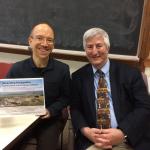Listening to N. T. Wright’s book The Challenge of Jesus (as an audiobook, checked out from my local public library via the Libby app straight to my phone) has given me a new appreciation for Wright’s work and conclusions, many or all of which are argued more thoroughly in others of his books, but in those contexts are not always woven together into story form in the manner they are here. I’ve noted often that the study of the historical Jesus is characterized by book-length studies for a good reason, although it is one that has only been getting its methodological due at the theoretical level relatively recently. Treated atomistically, sayings and actions can be interpreted in a great many ways in isolation from one another that simply won’t make sense within the framework of the evidence as a whole, or of the historical context of the individual in question. Wright seeks to weave together not only words, actions, and context, but also theological questions both ancient and modern in addition to the more standard historical ones. Given the size of the book, he manages to pack an impressive amount into this volume.
The book begins by surveying some of the history of the “Quest for the Historical Jesus.” He recognizes its connection with the Enlightenment and thus in turn with the Reformation and the desire to return to roots behind and beneath later dogmas. Wright suggests that the key early figures were, for the most part, asking the right questions even if they may be judged from our perspective as having given the wrong answers. By the end of the book, Wright will emphatically assert the importance of the postmodern chastening of an Enlightenment approach, while calling Christians to engage fully and deeply with both without simply embracing either. From a Christian perspective, the historical quest is a crucial one, for the simple reason that we should not consider ourselves free to invent our own Jesus.
Some of the contents were things that I was already familiar with, from Wright as well as others. His view of the hope in first century Judaism as being focused on an end to exile, for instance (a view I still find makes good sense of the relevant evidence), and his view of apocalyptic language as no more literal than our language of “earth shattering” events.
Other things were perhaps not new, but striking to hear articulated in precisely the way Wright did, or by him for that matter: for instance describing Jesus as like a politician garnering support for his movement, and explicitly placing him into the category of prophet (albeit not exclusively).
But some details were truly striking. For instance, I wasn’t aware that the language – the very terminology of “Repent and believe in me” – is to be found in Josephus!
In discussing Jesus’ statements about purity and social boundaries, Wright views these as going hand in hand with Jesus’ call to abandon concern for not defending oneself against enemies. This certainly seems to fit the symbolic function of purity rules as explored by Mary Douglas, Gordon Wenham, and others. But whether it is adequate in light of the challenge to the use of Judaism as a negative foil for Jesus as offered by Amy-Jill Levine (whose book Short Stories by Jesus is my next audiobook selection that I’ve begun listening to) is another matter. Wright’s suggestion that the Pharisees looking to discredit Jesus might have been like journalists seeking compromising photos, making their following him in a cornfield more plausible, is both intriguing and seemingly anachronistic, and may not genuinely recast the Pharisees as a historically plausible movement who do not merely continue to serve as stock enemies (albeit slightly different ones) in the story of Jesus.
In general, though, Wright seems to be able to adopt a balanced approach even to figures that might normally be merely contrasted with Jesus. For instance, he notes that Bar Kochba would have said (as Wright believes Jesus did) that the kingdom of God is both present and future. Wright argues for not avoiding questions about Jesus’ views either for reasons of piety or skepticism, but instead recommends recognizing Jesus as having been a “reflective theologian.” This does not make it possible to psychoanalyze Jesus (as some have tried to do), but it is possible for us to ask about his sense of vocation and intentions as evidenced by his actions.
Wright’s discussion (or rather mentions) of agency and Trinitarian theology leave unclear whether and to what extent I agree with Wright. At times, he seems to be situating Jesus fully within the context of first-century Jewish monotheism, understood in a manner not entirely unlike the way I myself understand it. At others, he seems to be at least trying to use language that will seem acceptable to those who are hoping to hear him affirm Nicene and Chalcedonian perspectives on Jesus when discussing them as a historical figure.
There are many details about which I will simply need to reflect further. For instance, the Greek translation of the Jewish scriptures has God say he will resurrect David’s son, where the Hebrew text – having God promise that he will raise up a descendant of David’s – doesn’t quite sound like that. Did the very earliest Christians read the Greek text and understand it in that way?
Wright views many of the parables that have traditionally been understood to be about his “second coming” to instead be about Yahweh’s return to Zion, embodied in and acting through Jesus. Wright suggests that Luke makes this clear through reference to “your visitation.” Having been listening to the book, I am not sure whether in the print version I would have found a footnote to Joachim Jeremias, who suggested something that at least bears comparison to Wright’s viewpoint.
Wright also has interesting things to say about texts that are not about Jesus, considered in their own right as well as in relation to the New Testament. For instance, Wright argues that the Wisdom of Solomon views immortality of the soul as an intermediate rather than a final state for the righteous, and thus also adheres to bodily resurrection (as indicated by the fact that those whose souls are in the hands of God will subsequently rule the nations).
There were also some interesting literary explorations of intertextual possibilities for interpreting New Testament texts (regardless of whether these may have been in view by the author). Wright views the pair of disciples on the road to Emmaus in the Gospel of Luke as Cleopas and his wife Mary. From there, he then finds connections and parallels both with Genesis (where another man and woman have their eyes opened, but in a different way) and with the story of Jesus in the temple at age 12.
I greatly appreciated how Wright articulated a vision for Christians expressing their faith in their workplaces in our postmodern context. Although my initial reaction to his postmodern recasting of the Emmaus story was disappointment, where he went after that – sharing a story of a visual artist who became a Christian, and then his own vocational journey – genuinely inspiring. And I found helpful his analogy between a critical realist approach (informed by Bernard Lonergan) and the experience of looking at the Mona Lisa at the Louvre through thick protective glass. We do not see things simply as they are, but neither do we merely see our own reflections, when seeking the historical Jesus. We ourselves and others around us end up reflected in our frame of vision. But we also catch clear glimpses of another enigmatic face as well.
I do want to say something about “reading” a book of this sort as an audiobook using the Libby app. It is very enjoyable to be able to “read” while doing other things, such as washing the dishes or riding a bicycle. But it is frustrating that the audiobooks accessed through the Libby app cannot be listened to through the sound system in one’s car. And I am certain there are things Wright said – sorry, wrote – that I would have written down and mentioned in this blog post if I were reviewing the print book. (Of course, I should acknowledge that I do have a copy of the print book – but it was sitting among my large collection of books that I am long overdue to review, and so I seized the opportunity to engage with the text in audio form rather than take even longer to get to it.) Like all media, including print books, this one has real advantages as well as some disadvantages. I’ll let readers of this review be the judge of whether listening rather than reading made my review less rich, less detailed, or less useful. But to judge that, you’ll need to read or listen to the book, and I encourage you to do so – and then to return here to share your thoughts!
















